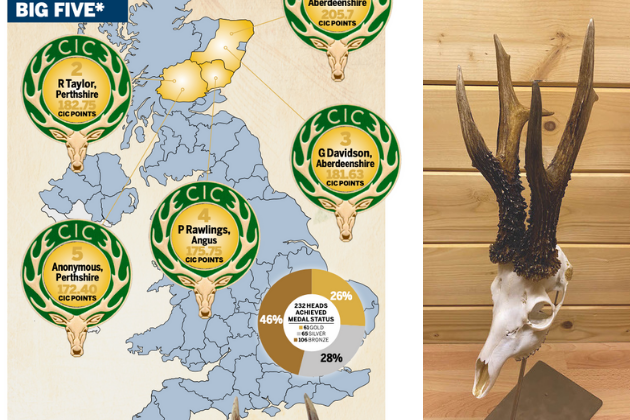Scottish roe review 2020
Yes, 2020 was a strange year, but it’s notable for exceptional roe heads, says Iain Watson

Despite COVID-19, figures for the Scottish 2020 list are impressive. From more than 260 roe heads presented, 232 were awarded CIC medals — 61 golds, 65 silvers and 106 bronzes. An astounding 19 heads achieved a score in excess of 150 CIC points, the level considered to be the benchmark for an international class one roebuck trophy.
Aberdeenshire seems to have nudged ahead of the other counties in terms of numbers of top-division roe recorded. This trend continued in 2020 but Perthshire has run it a close second with Fife and Angus not far behind.

Peter Rawling’s 175.5 head from Angus
Doubles
It’s always of interest to see where other top-class animals turn up from and mention goes to Mr Bryce for his 154.6-point buck from Easter Ross and to Chris McVey for his 153.43-point Lanarkshire buck. Mark Paterson has two Aberdeenshire entries above the 150 level as does Mr D Clarke with two Perthshire heads both above 160 points.
But undisputed at the top of the 2020 list is Gregor Davidson with three heads in the top 19. While his Aberdeenshire duo of 154.9 and 181.63 would turn heads at any European exhibition, his table leader at 205.7 joins a rare elite.
While it’s not possible to mention everyone, 2020 clearly has been exceptional for the number of very high-scoring trophies. A further two remarked upon by colleagues were Robert Taylor’s with a score of 182.75 and Peter Rawlings’s Angus head at 175.75. The dry weight scores for the top three were all in excess of 700g.

Gregor Davidson’s 205.7-point head of a roe aged about six from Aberdeenshire
Silver stories
While there were some pre-2020 heads submitted, the majority were from that year. The bronze entries far outweighed the silvers. The expectation is that the golds and the bronzes will roughly match each other with the biggest group being silver medal heads. In years where the majority submitted are bronze, it usually points to a younger class of animals being targeted, which may lead to issues down the line.
The autumn of 2020, both in terms of resources and weather, was generally kind to roe in Scotland and there was good residual food availability up until the festive period. It remains to be seen if a reduction in gamebird feeds results in a knock- on effect to roe quality in 2021 and what impact any further reduction in gamebird releases and management beyond next autumn has.
Bucks with well-formed antlers were reported from a number of Scottish locations through January, but we will have to wait to see if the period of harsh weather in February has any impact on the progress made up till then.
Clearly, though, 2020 presented a number of challenges, with deer behaviours in response to lockdown potentially being one. While some commentators suggested that reduced human activity would lead to increased confidence in animals — and thus reduced fear of humans — in many areas there was much-increased human access to the countryside. While this was largely socially distanced, it was seen to make animals more reclusive, particularly in areas on the suburban fringe.
Restrictions for us internally as Covid tier levels have increased, and externally for visitors to Scotland, have impacted on many recreational shooters but particularly on sporting agents and their hard-working teams.
Venison market
Issues in the venison market have been felt by many, with price reductions and collapses, thus major issues around saleability and market availability. This, coupled with long-term worries about future demand, given the difficulties faced by the hospitality and catering sectors, continues to cause anxiety. There have also been changes brought about by withdrawal from the European Union. In reality these changes and challenges will remain with us through 2021 and probably beyond.
The importance of roe to Scotland, and Scotland’s importance to roe deer as a species, has increased hugely in the past 40 years. The deer have gone from relatively low status to being shot in deer drives, to being recognised by many as one of our major sporting assets. This helps create revenue and employment across many sectors in our rural economy. Roe are an enormous asset to the countryside, regardless of what the naysayers claim, and one that we as stalkers deserve credit for managing.
This was brought home to me while I was working on updating the master list of the 50 strongest roe recorded by the CIC up to 2013. While I expected it to be dominated by central European counties, which it was, eight Scottish animals taken between 1976 and 2012 are included. They have all been properly validated, with six scoring in excess of 200 CIC points and two more than 220 points. Looking back to the 1980 Shooting Times roe review, there were 12 heads from Scotland, three gold, three silver, five bronze and one non-scorer — all in all quite a change.









